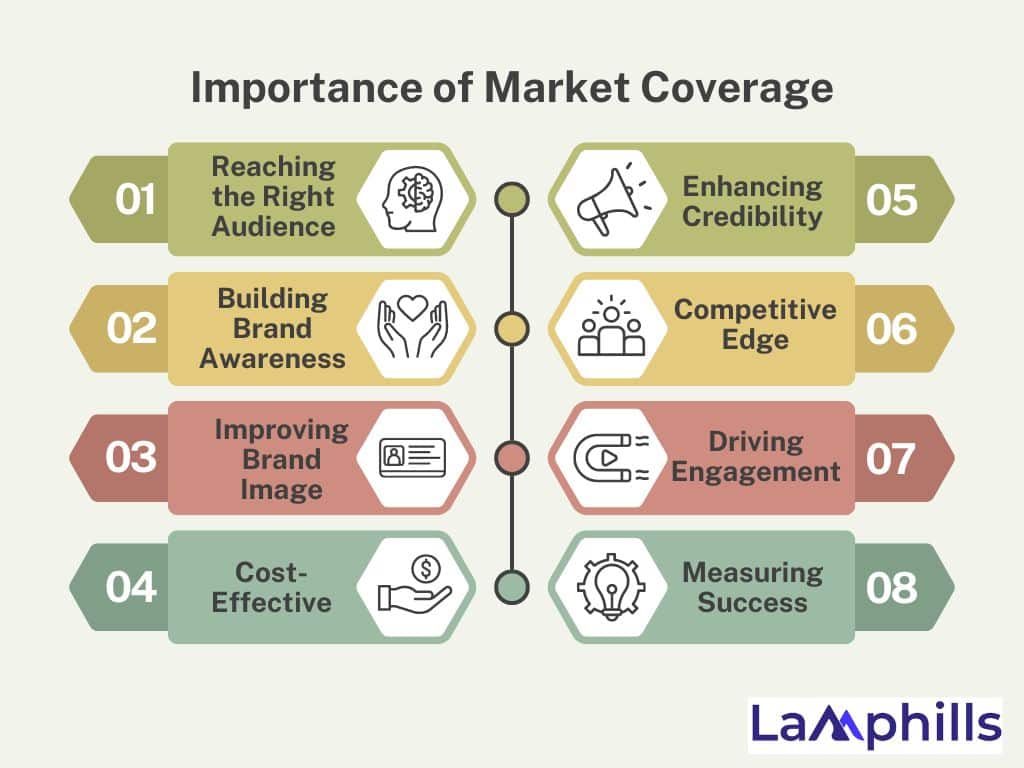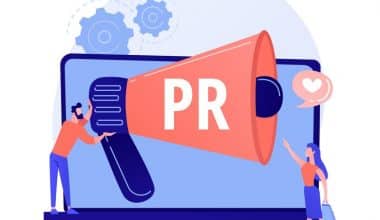I remember the first time I heard the term “market coverage.” At that time, I was a legal assistant at a law firm, trying to improve our PR efforts. The concept seemed confusing at first, but as I learned more, I realized it was the missing piece we needed. It took many attempts, late-night research, and a few mistakes, but our PR strategy improved significantly once I understood market coverage.
The cost of marketing and advertising your product or service is often high. Because of this, businesses need to plan their advertising strategies carefully. These strategies should achieve two goals: affordable and delivering the right message to the intended customers.
In other words, they must design a strategy to get the most benefit for the lowest cost. This introduces the idea of market coverage. Today, we will discuss market coverage, the different market coverage strategies, their importance for your PR strategy, expert tips, and factors to consider when choosing a market coverage strategy. Keep reading to learn more.
Key Points
- Market coverage ensures your product or service reaches the right audience through appropriate channels, encompassing where, who, and how it’s sold.
- Every marketing manager should know the three main types of market coverage: Intensive Distribution, Exclusive Distribution, and Selective Distribution.
- Adequate market coverage enhances brand awareness, credibility, and competitive edge while reaching the right audience efficiently.
- To achieve effective market coverage, businesses should understand their customers, choose suitable sales channels, offer variety, customize messages, and continually monitor strategies.
- When choosing a market coverage strategy, businesses should consider factors like target market size, customer preferences, competition, resources, product type, and budget to develop effective market coverage strategies.
What is Market Coverage?
Market coverage is how widely you make your product or service available to your target audience. It’s ensuring that your message reaches the right people at the right time and through the right channels. It includes where it’s sold, who it’s sold to, and how it’s sold to customers.
Imagine casting a net wide enough to catch all the fish you want in a big ocean of potential customers.
Market coverage strategy involves analyzing the market to decide how much of the total market your advertisement should reach for a specific product or service. Businesses also consider economic factors like customer wealth and cultural trends when analyzing the market.
They also examine how their product fits into the market. This analysis aims to develop a good and effective market coverage strategy. In simple terms, market coverage sets the foundation for creating a market strategy and planning everything based on it.
Now, it’s up to the business whether it wants to reach the entire market or just focus on a specific part of it. For example, a small business with limited resources might target its marketing and advertising to a particular part of the market. In contrast, a large business with many resources can aim to reach different parts of the market.
Types of Market Coverage Strategies
There are 3 main types of market coverage every marketing manager should know: Intensive Distribution, Exclusive Distribution, and Selective Distribution. These options let businesses distribute their products or services in different ways. Each method has its pros and cons. It’s important for a business to focus on how they will distribute their products and services because it can impact their brand image, sales, costs, and employees.
Let’s explain better:
#1. Intensive Distribution
Intensive distribution means getting your product or message out as widely as possible. It happens when a business wants to make its products available in as many places as possible. For example, soft drink and candy companies often use this method. Coca-Cola, for instance, aims to have its products within easy reach of customers everywhere.
Another example of intensive distribution is seen in e-commerce. An online business might sell products on its own website and on other sites like Amazon, eBay, and Groupon Stores.
Selling products through multiple channels can help reach more customers, but there might be better ideas for some brands. If a brand wants to be seen as high-end or luxury, being available everywhere can lower its perceived value.
When sales increase, costs often rise too. Distributing through physical stores can increase costs for shipping, manufacturing, warehousing, inventory, and staff like salespeople and customer service representatives.
These costs also apply to e-commerce, with additional referral fees. Many online marketplaces charge a fee of 3-15% per sale. Businesses may need to negotiate these fees with account managers or consider raising their prices on these platforms.
#2. Exclusive Distribution
Exclusive distribution creates a sense of scarcity and prestige by partnering with a limited number of outlets. Here, a company sells its products through a limited number of chosen retailers instead of trying to get its products into as many stores as possible. This approach aims to create a sense of exclusivity and increase the perceived value and quality of the product.
Apple uses this method by carefully selecting which retailers can sell its products. This allows Apple to ensure its products are showcased prominently and uniquely in stores. By doing this, Apple can also set specific conditions that retailers must follow to sell its products, such as how the products are displayed, the price, and what other items can be sold alongside them. This is called an exclusive distribution agreement. Retailers often seek out these agreements to carry popular products like Apple’s.
This approach can benefit both the retailer and the manufacturer. However, if the agreement requires the retailer to sell only one brand and none of its competitors, it can be risky. If demand for the product drops, the retailer could suffer. On the other hand, manufacturers usually avoid selling their products through only one retailer, which could significantly limit their growth and profits.
#3. Selective Distribution
This strategy falls between intensive and exclusive distribution. Selective distribution targets specific outlets that directly connect with your target audience. It involves choosing specific retail locations based on key factors like geographic location. This method benefits manufacturers because it allows them to target franchise businesses and other chains in areas where their target market is concentrated. It also helps control costs by limiting the number of sales channels.
Selective distribution is widespread among marketers because it allows them to focus their efforts on the most profitable areas. This approach is known as effective distribution, where a limited number of retail outlets account for a large market share.
For example, an expensive men’s wristwatch company might sell its products through only 40% of available stores. However, these stores make up 80% of the wristwatch market volume. Adding another retail outlet would only increase market volume by 5%, which might not be worth the additional costs. Therefore, the wristwatch company focuses on the outlets that already cover 80% of the market.
What is the Importance of Market Coverage for Your PR Strategy
Market coverage is key to a successful public relations (PR) strategy. It’s about making sure your product reaches the right people at the right time. This can greatly affect how well your business connects with potential customers and the public.

In other words, it means making sure as many relevant people as possible know about your brand, trust it, and choose it over competitors. Using the right market coverage is essential for several reasons, including:
#1. Reaching the Right Audience
In PR, it’s like sending out invitations to a party. You need to make sure they reach the people who would really want to come. Similarly, you need to ensure your messages reach the people who are most likely interested in what you offer. This makes your PR efforts more efficient.
#2. Building Brand Awareness
The more places your message appears, the more people will learn about your brand. Think of it like seeing your favorite snack in every store you visit; you start to recognize and remember it.
Consistent and strategic market coverage helps build brand awareness. By covering a wide market, more people learn about your brand. This awareness can lead to more potential customers and greater interest in what you offer.
#3. Improving Brand Image
By carefully choosing where and how you communicate, you can shape how people think about your brand. This is like dressing up for a job interview; you want to make the best impression.
#4. Cost-Effective
Effective market coverage helps you reach more people without wasting resources. It’s like using a map to find the best route to a destination; it saves time and fuel.
#5. Enhancing Credibility
Exclusive coverage can significantly enhance your brand’s credibility. For instance, when your brands consistently appear in various media, it helps build trust with your audience. People tend to trust brands they see and hear about often.
#6. Competitive Edge
If your PR messages cover the market better than your competitors, you’re more likely to be seen and heard. It’s like having the biggest sign at a fair; more people will notice you.
Also, if your competitors are reaching a broader audience, you must do the same to stay competitive. Good market coverage ensures you are visible in the same spaces as your competitors.
#7. Driving Engagement
Effective market coverage drives engagement by reaching your audience where they are most active. I remember a local cafe campaign where our social media posts got a lot of engagement because we targeted local community groups and food bloggers who influenced our audience.
#8. Measuring Success
Broader market coverage allows you to gather more data on how different segments of your audience respond to your PR efforts. This helps you to accurately measure the success of your PR efforts. In addition, this information can help you refine your strategy and improve future campaigns.
Market coverage isn’t just about spreading your message; it’s about spreading it wisely to ensure it has the most significant impact. To help you achieve this, we have listed some expert tips that will help your brand stand out among competitors.
Expert Tips for Effective Market Coverage
In market coverage, you need a good plan to reach and serve your customers while making more sales. Here are some simple tips to help businesses do just that. These expert tips can help businesses determine the best ways to connect with customers and ensure their satisfaction.
#1. Understand Your Customers
Know who your customers are, what they like, and what they need. By knowing what your customers like and need, you can provide them with the right products and services.
#2. Pick the Right Places to Sell
Imagine selling ice cream; where would you go? Places where it’s hot and there are lots of people, right? For your business, decide where to sell your products. This could be online through a website, in a physical store, or both. Choose the channels where your customers like to shop.
#3. Offer Variety
Just like a restaurant menu, having different items can attract more people. Offer a range of products or services that can cater to the needs of different customers. This way, you can attract more people to your business.
#4. Customize Your Messages
When you talk to your friends, you use words and ideas they like and understand. Do the same with your customers. Tailor your advertising and promotions to speak directly to your customers’ interests and needs, which will make your marketing more effective.
#5. Monitor and Adapt
Always check how well your strategies are working. If something isn’t working as well as you hoped, be ready to try new approaches. Staying flexible and adapting to change will help keep your business strong, relevant, and competitive in the market.
Using these simple strategies, any business can improve how it reaches and serves its customers. By understanding and adapting to customer needs, choosing the right places to sell, offering a variety of products, customizing marketing efforts, and always being ready to make changes, a business can ensure it covers its market effectively and keeps its customers satisfied.
Here’s a checklist to guide you through the steps to create a successful market coverage strategy, from understanding your market to choosing the right distribution methods and monitoring your progress.
By following this checklist, you can develop a market coverage strategy that ensures your product or service gets to the right audience.
Factors to Consider When Choosing a Market Coverage Strategy
Choosing the right market coverage strategy helps determine how a company reaches its customers and fulfils their needs. Here are some simple factors to consider when deciding on a market coverage strategy.
1. Target Market Size: Consider how big your target market is. If your market is large, you might need a broad strategy to reach many customers. For smaller markets, a more focused approach could be better.
2. Customer Needs and Preferences: Understand your customers’ needs and preferences for shopping. Tailoring your strategy to meet these needs will make your marketing more effective.
3. Competition: Look at what your competitors are doing. If there’s a lot of competition, you might need a unique approach to stand out. In a less competitive market, a straightforward strategy could work.
4. Resources and Capabilities: Evaluate your company’s resources and skills. A strategy that requires extensive resources might not be feasible for a small business.
5. Product Type: Consider the nature of your product. For example, niche products might need a targeted strategy, while everyday items could benefit from a mass-market approach.
6. Marketing Budget: Your budget will influence your strategy. A larger budget allows for a wider reach, while a smaller budget might require a more focused effort.
By carefully evaluating these factors, you can develop a strategy that effectively reaches your customers and supports your business goals.
Final Thought
Market coverage might seem complex, but once you understand it, it becomes a powerful tool in your PR strategy. Whether you’re launching a new product, entering a niche market, or establishing yourself as an industry leader, the right market coverage can make a huge difference.
So, what type of market coverage will you choose for your next PR campaign? The key is to match your strategy with your goals and audience. Doing so will maximize your reach and build a strong, credible, and engaging brand presence.
With this article, I want to make market coverage easier to understand. It’s a vital part of any PR strategy that, when done right, can bring outstanding results. Embrace it, experiment with it, and watch your PR efforts succeed.
Frequently Asked Questions
What is full market coverage?
Full market coverage means offering all your products to all customer groups. This strategy works well for companies with a lot of resources. However, a company needs to carefully consider its resources and the risks involved when deciding which and how many customer groups to target.
What is the customer coverage strategy?
Customer coverage explains how a business uses its sales channels, roles, processes, and resources to reach customers. It includes different ways to sell (like third-party resellers, referral partners, retailers, or the company’s own sales team), the roles of the salespeople, the steps they follow to make a sale, and how they are spread out to cover different areas or customers.
What are the four types of marketing?
Types of Marketing Plans and Strategies
1. Market Penetration Strategy: This is when a company focuses on selling its current products to its existing customers.
2. Market Development Strategy: This involves selling current products to new customers.
3. Product Development Strategy:* This is about creating new products to sell to existing customers.
4. Diversification Strategy: This involves creating new products to sell to new customers.
Why is it important to define your market?
You need to know who your customers are to make your business successful. Understanding your customers helps you find those who are ready to buy your product or service. This makes it easier and cheaper to reach them and grow your business.
What are the three levels of market coverage?
Here are the three levels of market coverage:
1. Intensive distribution means using all available stores to sell a product.
2. Selective distribution: This involves using only some of the stores in each area to sell a product.
3. Exclusive distribution: This is when a product is sold in only one store or a few stores in each area.
What does coverage mean in business?
Business income coverage is a type of insurance that helps a business if something bad happens. It helps the business recover money lost due to the problem and also covers the costs of running the business.
Similar Articles
What Is Relationship Marketing? All You Need To Know
Brand Marketing vs. Content Marketing: How They Differ and Work Together
Examples of Earned Media To Inspire Your Marketing Campaign






